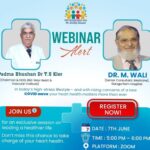People with risk factors such as a family history of diabetes must take precautions at an early age
healhysoch
New Delhi, May 21, 2019 :
A large-scale population-based study has found that only half the Indian adults in the most productive age group (15-49 years) are aware that they suffer from diabetes. Only one-fourth of those diagnosed and treated have their blood sugar under control. In light of the poor level of awareness, treatment and control, the need of the hour is to focus on primary prevention and screening efforts. This will help reduce the burden and impact of diabetes in India.
According to the WHO, there are about 62 million people living with diabetes in India, a number that is projected to increase to 70 million by 2025. The ‘lifestyle disease’ is a massive public health obstacle for the second most populated country in the world. Diabetes can increase the risk of life-threatening complications including kidney damage and heart disease.
Speaking about this, Padma Shri Awardee, Dr KK Aggarwal, President, HCFI, said, “A high-calorie diet rich in processed and junk food, obesity, and inactivity are some of the reasons for the increased number of younger people with diabetes in the country. Not getting checked in a timely manner and not following the doctor’s protocol further complicates matters for them, putting them at a risk of acquiring comorbid conditions at a relatively younger age. There is also a belief that because young people with Type 2 diabetes do not need insulin, it is not as sinister as it seems. However, this is a false notion. This condition requires immediate treatment and management.”
The symptoms of Type 2 diabetes develop slowly, over time. Some of them include increased thirst and hunger, frequent urination, weight loss, fatigue, blurred vision, slow healing of infections and wounds, and skin darkening in certain areas.
Adding further, Dr Aggarwal, who is also the Group Editor-in-Chief of IJCP, said, “Small and gradual changes can be made in the family so that no one is left out. This will also be encouraging for youngsters with adults setting examples for a healthy lifestyle. Such changes can help a youngster lose weight (if that is the issue) or help them make better eating choices.”
Our ancient rituals and traditions have given us a way out of this conundrum. They advocate the principles of ‘variety’ and ‘moderation’, that is, ieat a variety of foods, and in moderation.
They recommend including all seven colors (red, orange, yellow, green, blue/purple, white) and six tastes (sweet, sour, salty, bitter, pungent, and astringent) for a balanced diet.
HCFI’s Formula of 80 to live up to the age of 80 without lifestyle disorders.
- Keep lower BP, LDL ‘bad’ cholesterol levels, resting heart rate, fasting sugar and abdominal girth levels all less than 80.
- Walk 80 minutes a day, brisk walk for 80 min a week with a speed of 80 steps (at least) per minute
- Eat less and not more than 80 gm or ml of caloric food each meal.
- Observe cereal fast 80 days in a year.
- Do not smoke or be ready to shell out Rs. 80,000/- for treatment.
- Do not drink alcohol; if you do, do not consume more than 80 ml per day for men (50% for women) or 80 grams per week. Ten grams of alcohol is present in 30 ml or 1 oz of 80 proof liquor.
- If you are a heart patient, consider 80 mg aspirin and 80 mg atorvastatin a day.
- Keep kidney and lung functions more than 80%.
- Avoid exposure to PM 2.5 and PM 10 levels < 90 mcg/m3.
- Avoid exposure to >80 dB of noise.
- Take vitamin D through sunlight 80 days in a year.
- Do 80 cycles of pranayama (parasympathetic breathing) in a day with a speed of 4 per minute.
- Spend 80 minutes with yourself every day (relaxation, meditation, helping others etc.).
healthysoch







